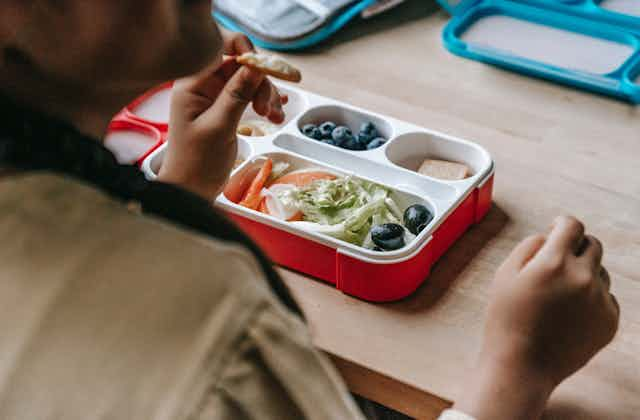Heading back to school is a time of great anticipation for many families, but it is not without challenges. One of the big challenges is preparing healthy, easy, affordable and appealing lunchboxes.
Lunchboxes are vital for supporting children’s energy levels throughout the school day, which in turn helps maintain their concentration.
What does a healthy lunchbox contain? How can you keep it fresh, while also keeping costs down?
Making a healthy lunchbox
A healthy well-balanced lunchbox should have four things:
1. food for energy: these foods have carbohydrates for energy to learn and play. This could be sandwiches, wraps, pasta or rice dishes
2. food for growth: these foods have protein to support growing bodies and minds. This could be lean meats, eggs, beans or dairy
3. food for health: these foods have vitamins and minerals to support healthy immune systems and include fruits and vegetables in a variety of colours
4. something to drink: water, milk or milk alternatives are the best choices. Do not give your children sugary drinks, including juice, cordial or energy drinks as they can lead to dental issues. If your child has trouble drinking plain water, try different bottles or cups. Some kids are more likely to drink from a strawed or spouted bottle. You can also try adding in a few drops of colourful fresh vegetable juice such as beetroot to make the water pink.

Choose snacks wisely
Most kids will eat a treat food over the core foods listed above (just like most adults!). These foods are fun and yummy but not the best choice for sustained energy and focus at school everyday.
So try and avoid snacks like fruit bars and straps, which are low in fibre, fluids, vitamins and minerals, and high in sugar. Also avoid dairy desserts such as custard pouches, biscuits, chocolate bars and muesli bars that are often high in fat and sugar and don’t need to be included in the lunchbox.
While homemade snacks like pikelets, scrolls or homemade dip are ideal and more cost effective, pre-packaged options can be a lifesaver for time-pressed parents.
When choosing packaged snacks, look for items under 600 kilojules per serving, low in saturated fat (less than 2 grams per serving) and containing fibre (more than 1 gram per serving).
Also look for nutrient-dense ingredients like low-fat dairy, wholegrains, fruits, vegetables, or beans to provide a more balanced snack selection. Good options include popcorn, dried fruit boxes, wholegrain crackers and cheese, mini rice cakes, tinned fruit cups and yoghurts without added sugars.
Read more: Sick of packing school lunches already? Here's how to make it easier
Keep lunch boxes easy
Try to make school food easy to handle and eat.
For younger children, cut up large pieces of fruit and vegetables, quarter sandwiches and choose things with easy-to-open packaging.
Involve your children in preparing and packing the lunchbox or show them the final product so they know its contents. This means the child is not surprised by the contents. They are also more likely to eat a meal they helped make.

Read more: Trying to spend less on food? Following the dietary guidelines might save you $160 a fortnight
Keep things fresh
Food can sit in lunchboxes for hours, so it’s important to keep it fresh. To help keep it as cool you can:
use an insulated lunchbox and ice pack. Pack the ice pack next to items prone to spoilage
if you are preparing the lunchbox the day before, store it in the fridge overnight
ask your kids to keep lunchboxes in their school bags, away from direct sunlight and heat
also consider freezing water bottles overnight to provide a cool and refreshing drink for hot days
if you know it’s going to be a particularly hot day or your child is going to be out and about with their lunch box, choose foods that don’t have to be kept cool. For example, baked beans, tetra pack milk, wholegrain crackers and diced fruit cups. Also consider uncut and whole raw fruit and vegetables such as an apple or orange, baby carrots, baby cucumbers or cherry tomatoes.
Keep costs down
There are several ways you can try to keep costs down when buying school lunch supplies:
follow the Australian Dietary Guidelines. A 2023 study suggests maintaining a healthy diet – along the lines of the guidelines – could save A$160 off a family of four’s fortnightly shopping bill
choose seasonal fruits and vegetables for the freshest items at lowest cost
take advantage of special deals or bulk purchases, especially for your child’s favourite snacks or things with a long shelf-life like canned or frozen foods
bake items such as scrolls or muesli bars and freeze in bulk when time allows. The One Handed Cooks have healthy recipes for all ages that are wallet and freezer friendly
use dinner leftovers as next-day lunches

- keep an eye on your child’s lunchbox to see what they eat. They may eat less during lunchtime but need a snack later. Adjust the lunchbox contents based on their hunger level and have a post-school snack prepared to avoid unnecessary food waste.
For more ideas on managing lunchboxes, check out the Grow&Go Toolbox. Nutrition Australia also has some great suggestions for balancing your child’s lunchbox.

